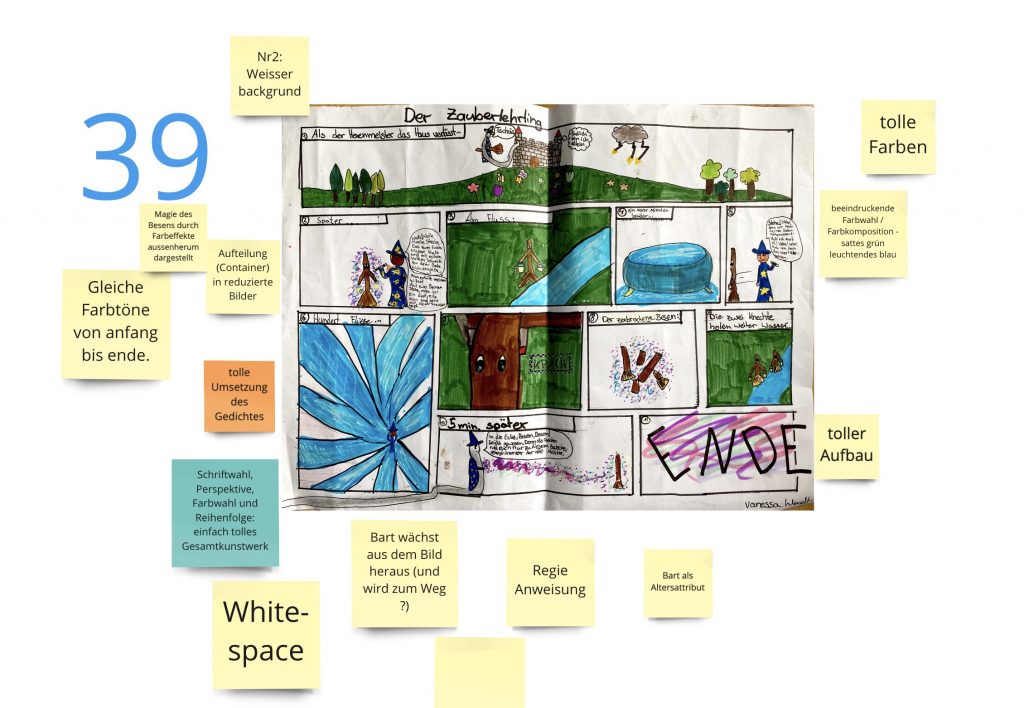10 Visualization Strategies We Can Learn from Children’s Drawings
Ever since my son was able to hold a pencil in his hand, I’ve been fascinated by how he teaches himself to draw. He develops his skills every day in a state of flow and with a lot of fun. I quickly realized that as a professional visualizer, there is a lot I can learn from his drawings.
by Martin Haussmann
SHARE ARTICLE
How do children visualize?
Jonas is 6 years old, and like all children his age that I know, is an enthusiastic visualizer. Drawing obviously has the same function for him as playing with Lego or Playmobil: he uses the pencil to immerse himself in the fantasy worlds of his stories. Like his room, his drawings are populated by knights, droids, dragons and samurais. In order to come up with picture stories, he needs a wide variety of figures and picture elements, just like adult visualizers. What distinguishes a ninja from a samurai? How can you depict a castle with a dungeon where a dragon is being held captive?
Since everything always has to be done quickly in a drawing, everything needs to be simple and uses only what’s at hand. From this approach, he develops amazing skills, similar to those we teach in our bikablo visualization training.

The top 10 intuitive visualization strategies I learned from my son.
- Iconic and symbolic: Jonas draws what he is passionate about at the moment: these are mostly fantasy stories, sometimes real events ie (“What did I experience today?”) and sometimes a mixture of both (“Last night I visited a stone giant and my deceased grandma in heaven.”
- Visuals and storytelling: he always tells stories with his drawings, often commenting on them out loud to me or to himself in parallel with how they are drawing.
- Visualization as a process …: When he begins, he knows his subject, then develops the plot and defines the outcome of the situation.
- … and for the dialogue: He draws to explain his ideas and does not care if others recognize what he has drawn without his help.
- Step-by-step approach: Action, interaction, and relationships emerge successively in Jonah’s drawings: first he draws a knight, next the tower he is standing on, and then he draws a cannon on top of it with a second tower that it shoots at, whereupon a fire flares up, which in turn is extinguished, and so on.
- Drawing outlines instead of the full image: You don’t always need to draw all the parts of an object, oftentimes just drawing the outline is enough. Even color is typically unnecessary for an object to be recognizable, usually one color is enough. This allows you to draw quickly without a lot of detail or the need for a full palette of colors.
- Systematic visual vocabulary: Jonas develops a systematic approach for objects and figures (knight: helmet, shield, sword), always draws the same thing and varies the figures only slightly, for example, to represent different knights.
- Spatial Awareness: Perspective is difficult and actually unnecessary. The bottom of the picture is in front, the top is behind, and things that are actually behind each other can just as well be drawn next to each other.
- Use of white space: Not everything on the page has to be filled in. White allows an image to breathe, it is the space in between: a field, the sea, or the sky. It can be tempting to fill this space, but oftentimes it is more effective if it is left empty.
- Letting go and appreciation: sometimes he doesn’t like the picture afterwards, then he tears it up and starts a new draft. Sometimes he wants to give it to me or someone else.
WEITERE ARTIKEL ZU DIESEM THEMA
Auch interessant

bikablo: Top in the SZ training ranking
In the 2024 continuing education ranking by Süddeutsche Zeitung (largest german broadsheet newspaper), our visualization training ranks at the top in the creative field – even ahead of major providers like Udemy or ZEIT Akademie. How is it that we, as a relatively small ‘training boutique,’ perform so well?

How to use your iPad instead of the webcam in MS Teams
Why do I want to connect the iPad to MS Teams (or Zoom)?
I would like to be able to show my iPad Screen as a tile in the normal Teams window. It should be subtle and not by sharing my screen to draw to much attention and to have a seamless switch between different views. I can i.e.
• document the meeting using OneNote or ProCreate
• easily zoom into pictures or drawing
• easily annotate pictures or digital whiteboards
• using the drawing feature while presenting your content

Design Thinking and Visual Thinking – a perfect fit?
In a recent interview Hiromi Hara speaks about her experience with applying the design thinking method with the help of visualization.
Hara explains that design thinking is not primarily about problem solving, rather about unveiling complex problems and getting better insight in the root cause of issues, hence the importance of the expression of individual perception and the comprehensible yet memorable depiction of thinking processes.